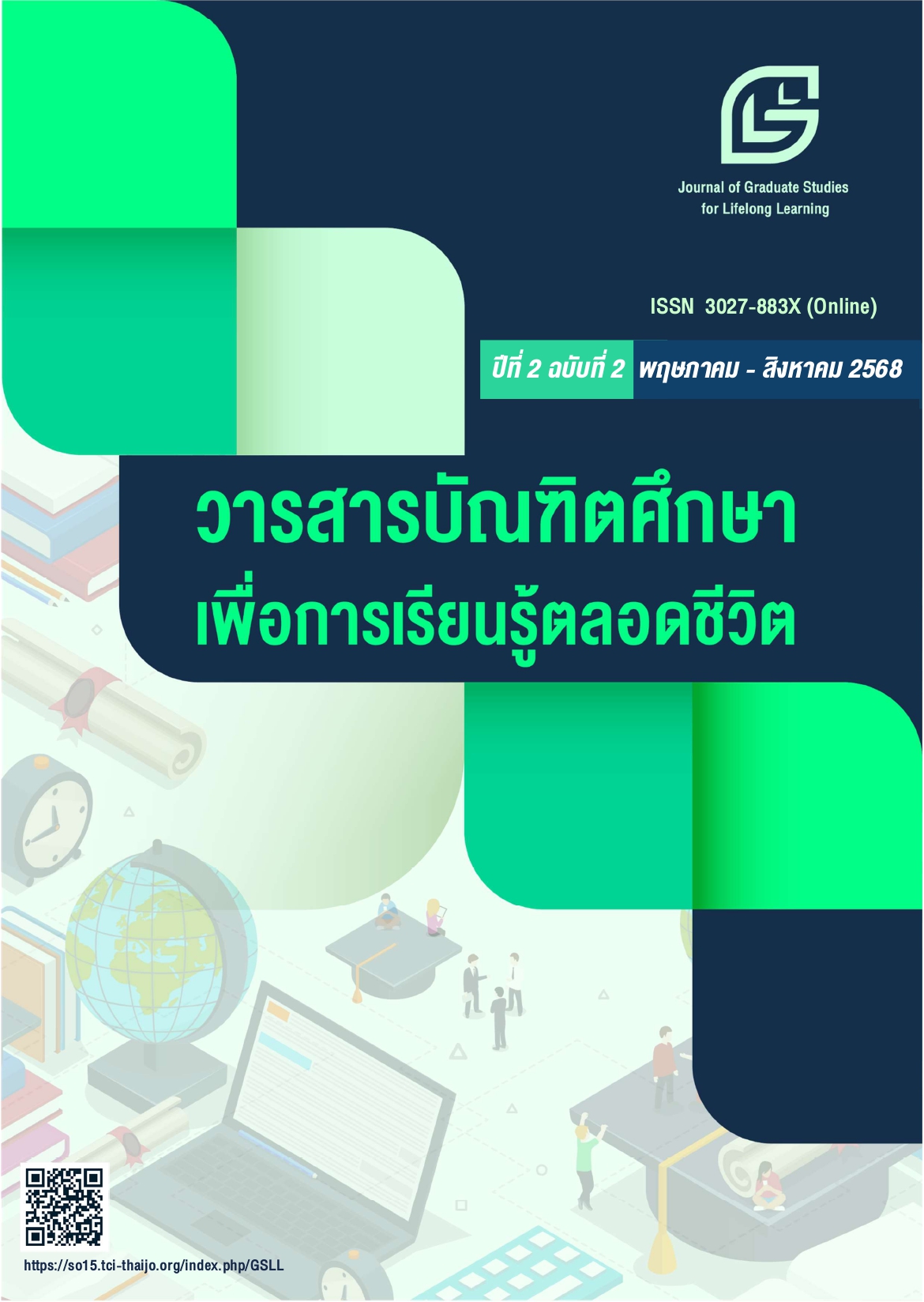Factors Affecting Hypertension Prevention Behaviors Among Individuals at Risk in Phipun District, Nakhon Si Thammarat Province
Main Article Content
Abstract
This cross-sectional survey aimed to examine: 1) knowledge about hypertension, attitudes toward hypertension, and social support; 2) hypertension prevention behaviors; and 3) factors influencing hypertension prevention behaviors among individuals at risk in Phipun District, Nakhon Si Thammarat Province. The sample consisted of 184 individuals selected through systematic sampling. The research instrument was a questionnaire. Content validity was evaluated by three experts, with item-objective congruence (IOC) values ranging from 0.67 to 1.00. The reliability of the knowledge section was assessed using the Kuder-Richardson Formula 20 (KR-20), yielding a coefficient of 0.72. The attitude, social support, and prevention behavior sections were assessed using Cronbach’s alpha, with coefficients of 0.811, 0.842, and 0.873, respectively. Data were analyzed using descriptive statistics and stepwise regression analysis.
The findings revealed that most participants had high knowledge, low attitudes toward hypertension, high social support for hypertension prevention, and moderate levels of prevention behaviors. Significant predictors of hypertension prevention behaviors included occupation (housewife), education level (bachelor’s degree), and gender (female), all of which positively influenced attitudes. In contrast, having a first-degree relative with hypertension had a negative influence. These variables collectively explained 16.0% of the variance in hypertension prevention behaviors, with statistical significance (p < 0.05).
It is recommended that relevant agencies implement targeted campaigns for at-risk individuals particularly those with first-degree relatives with hypertension to foster positive attitudes toward prevention and promote behavior modification programs.
Article Details

This work is licensed under a Creative Commons Attribution-NonCommercial-NoDerivatives 4.0 International License.
References
กรมควบคุมโรค กระทรวงสาธารณสุข. (2562, 21 ธันวาคม 2562). รายงานประจำปี 2562. https://ddc.moph.go.th/uploads/publish/955420191221133437.pdf.
จันทร์ทรา จีนกลับ, นาเดีย ดะแซ, ซูไฮลา เจะเล็ง, พัทมาวาตี ลาเต๊ะ, อาร์ลีมันท์ เบญจมามาศ, ซูไฮมิง บือซา, ชิษณุพงศ์ หนูทิม,จันทร์ญา ธนะปฐมชัย และกฤตพร สิริสม. (2567). ปัจจัยที่มีความสัมพันธ์กับพฤติกรรมการสร้างเสริมของกลุ่มเสี่ยงโรคความดันโลหิตสูง: กรณีศึกษาอำเภอป่าพะยอม จังหวัดพัทลุง. วารสารการพยาบาลและการดูแลสุขภาพ, 42(4), e275113.
ทิพย์สุคนธ์ ศรีลาธรรม, สุรีย์ จันทรโมลี และประภาเพ็ญ สุวรรณ. (2564). ปัจจัยเชิงสาเหตุที่มีผลต่อพฤติกรรมการป้องกันโรคความดันโลหิตสูงของประชาชนกลุ่มเสี่ยง เขตสุขภาพที่ 4 กระทรวงสาธารณสุข. วารสารสังคมศาสตร์และมานุษยวิทยาเชิงพุทธ, 6(12), 425-438.
ทีนุชา ทันวงศ์. (2565). ปัจจัยที่มีความสัมพันธ์กับพฤติกรรมการดูแลสุขภาพตนเองของประชาชนกลุ่มเสี่ยงโรคความดันโลหิตสูง อำเภอเขาย้อย จังหวัดเพชรบุรี. วารสารวิทยาลัยพยาบาลพระจอมเกล้า จังหวัดเพชรบุรี, 5(2), 28-43.
นันทนาถ ช่วยสกุล. (ม.ป.ป.). ศึกษาปัจจัยที่มีอิทธิพลต่อพฤติกรรมสุขภาพที่พึงประสงค์ในกลุ่มวัยทำงาน เขตสุขภาพที่ 11. ศูนย์อนามัยที่ 11 นครศรีธรรมราช, https://hpc11.anamai.moph.go.th/th/owc-64/download/?did=215407&id=95631&reload=.
พัชราวดี ทองเนื่อง และอัญณ์ยภัคสร ใจสมคม. (2562). ปัจจัยทำนายความตั้งใจในการปฏิบัติตนเพื่อป้องกันการเกิดโรคความดันโลหิตสูงของประชากรวัยผู้ใหญ่. วารสารพยาบาลโรคหัวใจและทรวงอก, 30(2), 49-65.
สมใจ จางวาง, เทพกร พิทยภินัน และนิรชร ชูติพัฒนะ. (2559). ปัจจัยที่มีความสัมพันธ์กับพฤติกรรมการดูแลตนเองเพื่อป้องกันโรคเบาหวานและความดันโลหิตสูงของประชาชนกลุ่มเสี่ยง. วารสารเครือข่ายวิทยาลัยพยาบาลและการสาธารณสุขภาคใต้, 3(1), 110-128.
สมาคมความดันโลหิตสูงแห่งประเทศไทย. (2562). แนวทางการรักษาโรคความดันโลหิตสูงในเวชปฏิบัติทั่วไป พ.ศ. 2562. ทริค ธิงค์.
สุธี สฤษฎิ์ศิริ, วรรณีย์ จิรอังกูลสกุล และธิติยา มีชัย. (2567). ความสัมพันธ์ระหว่าง ความรู้ ทัศนคติ พฤติกรรม ในการป้องกันควบคุมโรคความดันโลหิตสูงและโรคเบาหวาน กับภาวะสุขภาพของผู้สูงอายุ 60 - 69 ปี เขตทวีวัฒนา กรุงเทพมหานคร. วารสารสถาบันป้องกันควบคุมโรคเขตเมือง, 9(1), 241-260.
สำนักงานสาธารณสขอำเภอพิปูน. (2567). รายงานการคัดกรองโรคความดันโลหิตสูง. สำนักงานสาธารณสุขจังหวัดนครศรีธรรมราช.
สำนักงานสาธารณสุขจังหวัดนครศรีธรรมราช. (2567). ข้อมูลการคัดกรองโรคความดันโลหิตสูง. กระทรวงสาธารณสุข.
อุดมพร ยิ่งไพบูลย์สุข, ส่าหรี แดงทองดี และแว่นใจ นาคะสุวรรณ. (2565). ปัจจัยที่มีความสัมพันธ์กับพฤติกรรมการดูแลสุขภาพเพื่อป้องกันภาวะแทรกซ้อนโรคความดันโลหิตสูงและเบาหวานของผู้สูงอายุในชมรมผู้สูงอายุวัดปุรณาวาส กรุงเทพมหานคร. วารสารวิชาการราชวิทยาลัยจุฬาภรณ์, 4(4), 179-188.
อัณญ์ยภัคสร ใจสมคม, พัชราวดี ทองเนื่อง,นันทิยา โข้ยนึ่ง, ธิดารัตน์หวังสวัสดิ์, นูรดีนี ดือเระ และพัชรี รัตนพงษ์. (2562). ปัจจัยที่มีความสัมพันธ์กับพฤติกรรมสุขภาพเพื่อป้องกันภาวะความดันโลหิตสูงของผู้ใหญ่ไทยที่มีภาวะก่อนเป็นโรคความดันโลหิตสูง. วารสารมหาวิทยาลัยนราธิวาสราชนครินทร์, 12(3), 1-18.
Best, J. W.. (1977). Research in Education (3rd ed.). Prentice Hall.
Bloom, B. S. (1971). Human Characteristics and School Learning. McGraw Hill.
Cohen, J. (1988). Statistical power analysis for the behavioral sciences (2nd ed.). Lawrence Erlbaum Associates.
Faul, F., Erdfelder, E., Lang, A. G., & Buchner, A. (2007). G*Power 3: A flexible statistical power analysis program for the social, behavioral, and biomedical sciences. Behavior Research Methods, 39(2), 175-191.
Likert, R. (1932). A technique for the measurement of attitudes. The Science Press.
Naing, L., Winn, T., & Rusli, B. N. (2006). Practical issues in calculating the sample size for prevalence studies. Archivers of Orofacial Sciences, 1, 9-14.
Pender, N. J. (1996). Health promotion in nursing practice (3rd ed.). Appleton & Lange.


